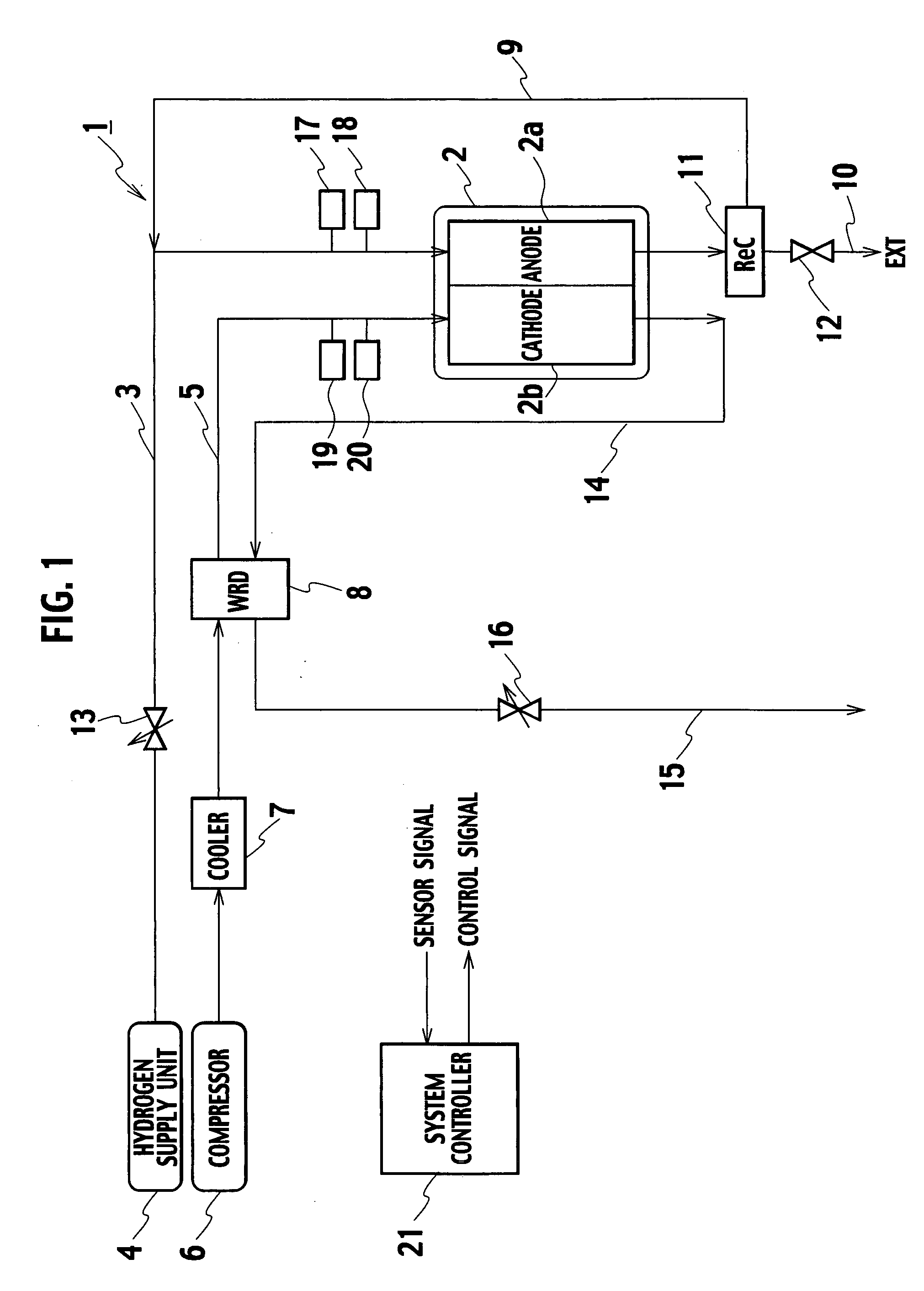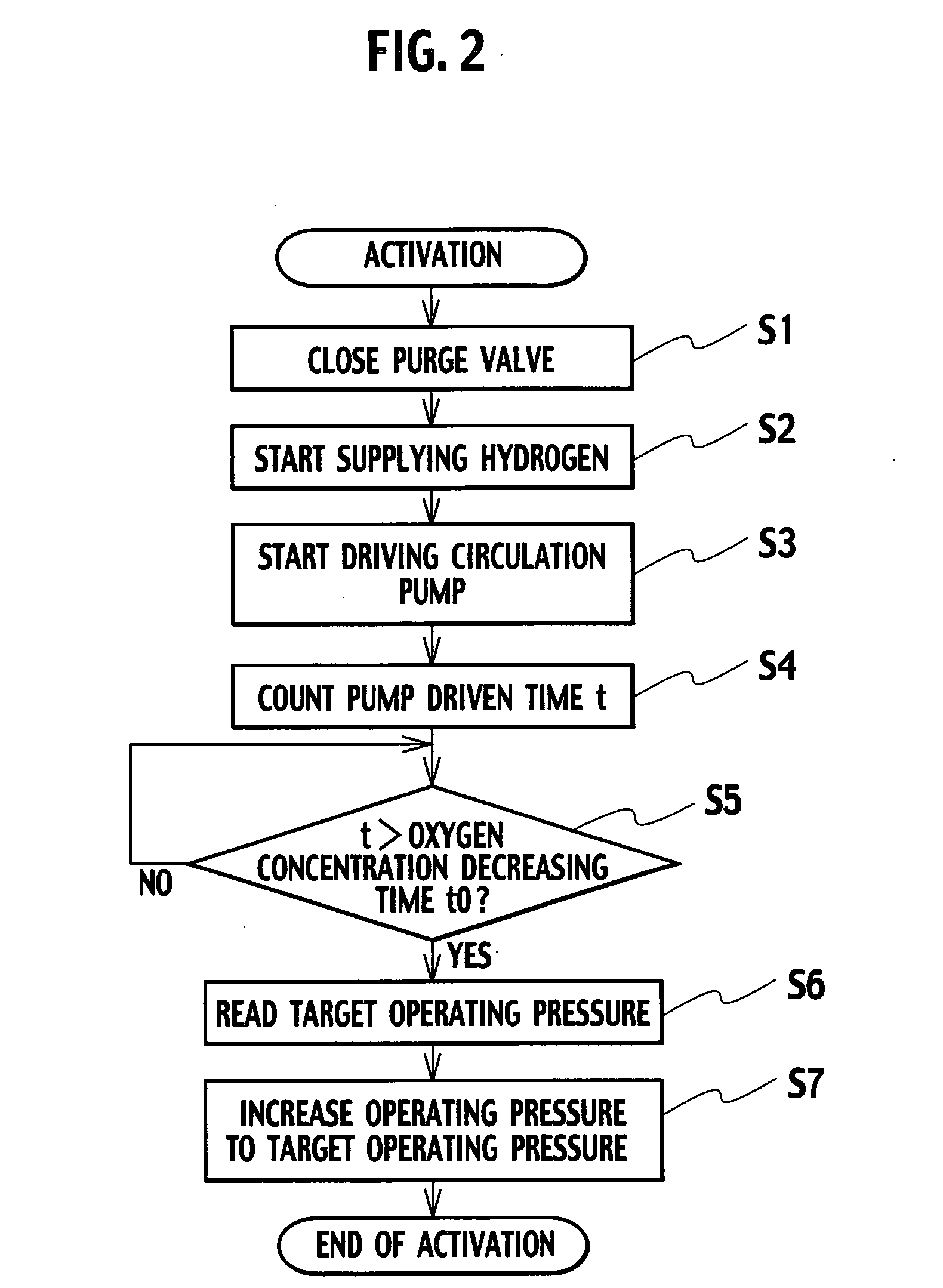Fuel cell system
a fuel cell and system technology, applied in the field of fuel cell systems, can solve the problems of degrading the fuel cell and difficulty in simplifying the layout of the fuel cell system, and achieve the effects of preventing the degradation of the components of the fuel cell stack, suppressing local generation of electric potential and heat, and reducing the amount of gas mixture of remaining oxygen
- Summary
- Abstract
- Description
- Claims
- Application Information
AI Technical Summary
Benefits of technology
Problems solved by technology
Method used
Image
Examples
first embodiment
[0034] A fuel cell system 1 as the present invention includes, as shown in FIG. 1, a fuel cell stack 2, a hydrogen supply unit 4, a compressor 6, an aftercooler 7, and a humidifier unit 8. The fuel cell stack 2 includes a plurality of fuel cells stacked, and the fuel cells generate electricity using hydrogen and air. The hydrogen supply unit 4 supplies hydrogen to an anode 2a of the fuel cell stack 2 through a hydrogen supply pipe 3. The compressor 6 supplies air to a cathode 2b of the fuel cell stack 2 through an air supply pipe 5. The aftercooler 7 cools the air supplied to the cathode 2b to a temperature suitable for power generation of the fuel cells. The humidifier unit 8 humidifies the air supplied to the cathode 2b.
[0035] The fuel cell system 1 further includes a gas circulator 11, a purge valve 12, a pressure regulating valve 13, a pipe 14, an exhaust pipe 15, and a pressure regulating valve 16. The gas circulator 11 circulates hydrogen which has not been consumed and disch...
second embodiment
[0054] As apparent from the above description, according to the fuel cell system 31 as the present invention, the system controller 21 increases the anode operating pressure after the oxygen concentration in the anode circulation path 9 decreases to such an oxygen concentration that degradation of the components of the fuel cell stack 2 is not caused. It is therefore possible to suppress degradation of the components of the fuel cell stack 2 even when the anode operating pressure is increased.
[0055] A fuel cell system as the third embodiment of the present invention has the same configuration as that of the fuel cell system as the second embodiment of the present invention. The system controller 21 executes the following activation process to prevent degradation of the components of the fuel cell stack 2 when the anode operating pressure is increased. Hereinafter, a description is given of an operation of the system controller 21 executing the activation process with reference to a ...
third embodiment
[0059] As apparent from the above description, according to the fuel cell system 31 as the present invention, the system controller 21 increases the anode operating pressure upon the oxygen concentration in the anode circulation path 9 being reduced to the predetermined oxygen concentration or less or upon the pump driven time t reaching the oxygen concentration decreasing time t0 or more. It is therefore possible to prevent degradation of the components of the fuel cell stack 2 even when the anode operating pressure is increased.
[0060] In a general fuel cell system, hydrogen, nitrogen, and vapor are mixed in the anode right after the system is stopped. When hydrogen in the anode is not discharged while the system is stopped, as shown in FIG. 7, the hydrogen concentration in the anode decreases over time because of crossover to the cathode, and on the other hand, the nitrogen concentration increases because of crossover from the cathode. The vapor concentration decreases as the temp...
PUM
| Property | Measurement | Unit |
|---|---|---|
| operating pressure | aaaaa | aaaaa |
| concentration | aaaaa | aaaaa |
| concentration detection | aaaaa | aaaaa |
Abstract
Description
Claims
Application Information
 Login to View More
Login to View More - R&D
- Intellectual Property
- Life Sciences
- Materials
- Tech Scout
- Unparalleled Data Quality
- Higher Quality Content
- 60% Fewer Hallucinations
Browse by: Latest US Patents, China's latest patents, Technical Efficacy Thesaurus, Application Domain, Technology Topic, Popular Technical Reports.
© 2025 PatSnap. All rights reserved.Legal|Privacy policy|Modern Slavery Act Transparency Statement|Sitemap|About US| Contact US: help@patsnap.com



